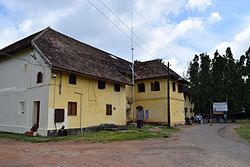Dutch Palace
| Mattancherry Palace | |
|---|---|
 |
|
| Location | Cochin, Kerala, India |
| Coordinates | 9°57′29″N 76°15′32″E / 9.958°N 76.259°ECoordinates: 9°57′29″N 76°15′32″E / 9.958°N 76.259°E |
| Type | Cultural |
| State Party |
|
The Mattancherry Palace is a Portuguese palace popularly known as the Dutch Palace, in Mattancherry, Kochi, in the Indian state of Kerala which features Kerala murals depicting portraits and exhibits of the Rajas of Kochi.
The Palace was built and gifted by the Portuguese as a present to the king of Cochin around 1555. The Dutch carried out some extensions and renovations in the palace in 1663, and thereafter it was popularly called Dutch Palace. The rajas also made more improvements to it. Today, it is a portrait gallery of the Cochin Rajas and notable for some of the best mythological murals in India, which are in the best traditions of Hindu temple art. The palace was built to appease the king after they plundered a temple nearby.
The landing of Vasco da Gama, the Portuguese explorer at Kappad in 1498 was welcomed by the Kochi rulers. They were given exclusive right to construct factories. The Portuguese repulsed the repeated attacks of the Zamorians and the Cochin Rajas practically became vassals of the Portuguese. The influence of the Portuguese were supplanted by the Dutch and they took over Mattancherry in 1663. Subsequently, the area was taken over by Hyder Ali and still later by the British East India Company
The palace is a quadrangular structure built in Nālukettu style, the traditional Kerala style of architecture, with a courtyard in the middle. In the courtyard there stands a small temple dedicated to 'Pazhayannur Bhagavati', the protective goddess of the Kochi royal family. There are two more temples on either side of the Palace, one dedicated to Lord Krishna and the other to Lord Siva. Certain elements of architecture, as for example the nature of its arches and the proportion of its chambers are indicative of European influence in basic Nālukettu style.
...
Wikipedia

